Bit of a rush job this week but there are still wonders to behold, even though two of them are a bit sparse of text and references. Fear not, they will arrive tomorrow.
Had a hectic week, an eye test, and a grumpy dog who wants to go in the garden every two minutes. The eye test revealed I need new glasses, and so I have them coming, but they will not be here for a week or so, and suddenly I find I am struggling with the old ones, and in poor light too. That is another reason why this is slow, because I have not wanted to strain by looking in books with tiny text until the light is better, and several days this week it rained so was even duller than usual.
I did manage to sort out some of the Card Index though, and the changes or additions this week are :
Ardath Tobacco Co. Ltd [tobacco : UK] "Famous Footballers" (August 1934) - https://csgb.co.uk/cardoftheday/2022-07-30
Alexander Boguslavsky, Ltd [tobacco : UK] “Sports Records” - first series (1925) - https://csgb.co.uk/cardoftheday/2022-03-31
Carreras [tobacco : UK] "Believe it or Not" (October 1934) - https://csgb.co.uk/cardoftheday/2022-03-25
Lamberts [trade : tea : UK] "Sports and Games" (1964) - https://csgb.co.uk/cardoftheday/2022-03-30
J. Lees [tobacco : UK] "Northampton Town Footballers" (1912) - https://csgb.co.uk/cardoftheday/2022-08-13
Olleschau [tobacco : UK] "Bookmarks" (undated) - https://csgb.co.uk/cardoftheday/2023-01-30
last card added
https://csgb.co.uk/cardoftheday/2022-03-24 (Panini "Royal Family" (1991)
Anyway there are joys still to behold in this rather shortened newsletter. And I could do with a better scan for one of them. Also, as usual, we will be delighted with your comments, memories, and updates. Keep them coming, for you turn the newsletters into a joint effort, rather than me, waffling.
So without any more of that, here is this week`s newsletter
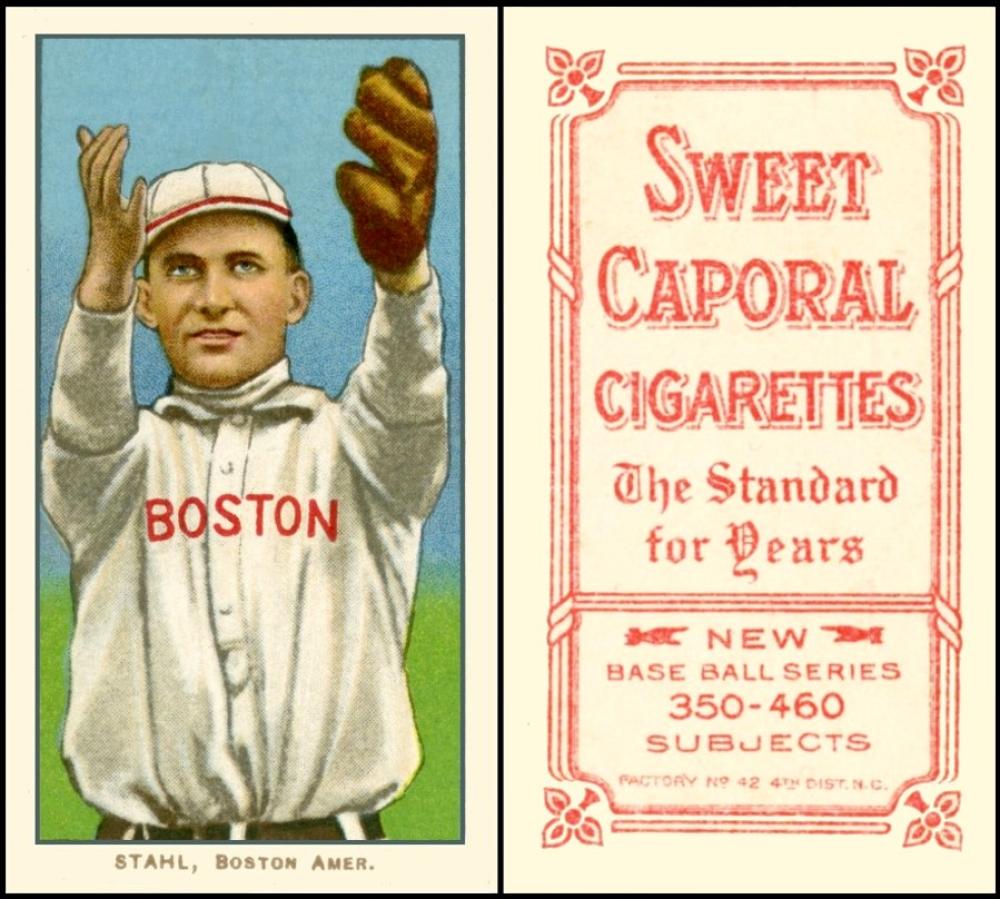
American Tobacco Company Group Issues [tobacco : O/S : USA] "New Base Ball Series - Burdick T.206" (1909) Un/110 - A565-034.3.E : A54-17.3.E : ABC/T.206 : USA/T.206
Today we celebrate National Red Sox Day, which is always the third Saturday in February. This year, if you are in the Boston Area, they have an open day and festival at Fenway Park, where they have played their home games since 1912. That does indeed make it the oldest baseball ground still in continuous use. However they did not start there, that was at Huntington Avenue, where they were based between 1901 and 1911.
I am well stumped by why this date is their National Day though. Any Red Sox fans out there? Or other team-trivia fans who happen to know?
Our man is easier to track down. He was Garland "Jake" Stahl, and he moved from being a player to a manager, and to leading the Red Sox to their second World Championship. He was born in April 1879, in Illinois, and died in September 1922, in California, aged just forty-three.
His first baseball games were played in the position of catcher. This was with the Boston Americans, and he joined them in 1903, two years after they had been founded. They were one of the first eight teams to join the American League. In 1906, they had an amazingly bad season, losing over a hundred games, and unsurprisingly ending up last in the league. Somehow it was felt that a name change would also be a luck change, and so in 1907 they changed their name to the Boston Red Sox.
However our man did not play with them forever, he moved first to the Washington Senators and to a new playing position of first base. It was only in 1912 that he became player-manager of the Boston Red Sox, and he led them to win the World Series in that year. The year before that he had not played at all, going off and becoming a bank manager. Now reading between the lines it appears that he did indeed simply go off and not turn up, this led to all kinds of strife when he wanted to become the manager but it was all sorted out in the end.
After leaving the team, which again he did by simply resigning, he again went back to banking. His father in law was a banker, but it appears there is more to it than that because the nature of the job is very slow and sedentary. He had lots of trouble with illnesses, and had a nervous breakdown in 1919, which sent him to a sanitarium in California, where he ended up with tuberculosis, and died in 1922.
There is another, rather shocking, fact, when you know of his health, because it is said that he is the "Jake" referred to in the baseball term "Jake-ing", which means saying you are sick or injured when you are not, or not pulling your weight on a team.
So let us examine this curious card, and the brand "Sweet Caporal", which will often lead you to a company called Kinney Bros., or Kinney Tobacco Company of New York. However their usage of this brand was early, in 1884 to 1890, when they became part of the American Tobacco Company.
Another user was the Imperial Tobacco Company of Canada, who were formed in 1902, and were a Canadian associate of British American Tobacco, beginning to issue cards the following year.
The secret is to see what follows the "Sweet Caporal", which here is "Cigarettes" but could also be "Little Cigars" or "Tobacco Wrappers". Any of these terms takes you straight to the American Tobacco Company of New York, which was formed in 1890 by the amalgamation of five leading American tobacco firms, these being Allen & Ginter, Duke, Goodwin, Kimball, and Kinney. At first the cards this new company issued said "Branch of the American Tobacco Company", or "American Tobacco Company, Successors". The Group issues began in 1900 and lasted until 1917 , during which time they pulled about two hundred and fifty smaller companies beneath their wings, and were responsible for making eighty per cent of all tobacco products used within the United States of America.
Another clue to this issuer is that cards often have numbers on them, and these refer to the factories, right across America, in which their goods were made and packaged up. It is not, as you may be told, where the cards were printed, that was done by the American Lithographic Co. in New York City. Our card says Factory 42, 4th District, N.C. That was based in Durham, North Carolina, and actually belonged to Liggett & Myers.
In 1908 The American Tobacco Company was caught up in a problem, that being their violation of The Sherman Anti-Trust Act, This had been passed in 1890 to stop companies buying lots of rivals up and forming a monopoly. The matter went before the Supreme Court, and they found American Tobacco to be in breach, ordering them to close and to form back into smaller companies one of which was Liggett & Myers.
Jefferson Burdick lists this set, slightly confusingly, as :
T.206 Baseball Players. (522). White borders. See Appendix 10. .10
Southern Leagues ...... .25 O`Hara and Demmitt $1.00
Sweet Cap., Piedmont, Sovereign, Cycle, American Beauty, Broadleaf, Drums, Old Mill, Polar Bear, Tolstoi, Hindu, El Principe de Gales, Carolina Brights, Uzit, Lenox, Ty Cobb. Series of 150, 350, 460, and assorted.
But of course, with hindsight, the numbers that have dots before them are the monetary values, with the first price being the general price for that set and the second showing us the cards and players who were more valuable.
Appendix 10 reads :
10. Baseball T.206.
Value 25c for cards No. 4, 208, 242.
50c for cards No. 168, 172, 347a.
$1.00 for cards No. 104, 148, 383.
$10.00 each for Plank No. 143. [Eddie Plank, Philadelphia Americans, American League]
$50.00 for Wagner No. 368 [Honus Wagner, Pittsburgh, National League]
As always the bold type is extra info. Not sure who the other numbers are of though, because every checklist I found has them different. But if you know, tell us.
Now this card is catalogued in our original World Tobacco Issues Index as part of a larger "Baseball Series" listing in our original World Tobacco Issues Index, referencing back to Jefferson Burdick, who coded it as T.206. It splits into four subsections, which revolve around the back wording relating to the numbers in the set. The header to all reads : "BASEBALL SERIES - BURDICK T.206 (A). Sm. 67 x 37. White borders. Unnd (522). Brand issues, selected subjects for some brands. See ABC/T.206. Ref USA/T.206."
The first two of these subsets, briefly, are
-
1. Inscribed "Base Ball Series - 150 Subjects"
-
2. Inscribed "Base Ball Series - 350 Subjects"
Our set is :
3. Inscribed "New Base Ball Series - 350 - 460" or "Base Ball Series - 460 Subjects".
A. "American Beauty"
B. "Cycle"
C. "Piedmont"
D. "Sovereign"
E. "Sweet Caporal Cigarettes"
After this there is a listing within the same group that lists nine brands which never gave the number of subjects in the set. And after that it goes into Series T.207.
The only difference to this listing in the modern update of the World Tobacco Issues Index is that the header does not cite "ABC/T.206", and that the end of our series` listing now closes with "F.25, 30, 42 in frame, altered to 42 below frame."
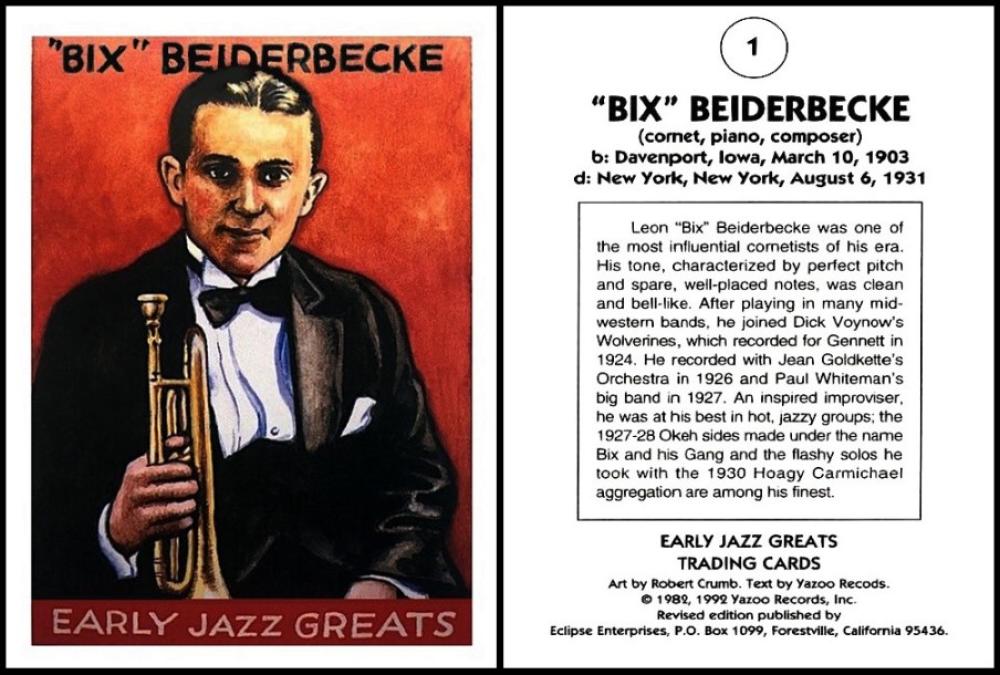
Eclipse Enterprises [Commercial : O/S : USA] “Early Jazz Greats” (1992 revised edition) 1/36
A century ago today, in 1924, Bix Beiderbecke made his recording debut with the Wolverines. The record was Fidgety Feet / Jazz Me Blues
This card was drawn by Robert Crumb, and the text supplied by Yazoo Records. That text tells us that Mr. Beiderbecke was actually called Leon and “Bix” was a nickname. It also says that “the Wolverines” were run by Dick Voynow, and they first recorded for Gennett in 1924, so that may have been this very event.
There are thirty-six cards in this set, and they came in a cardboard box all at once. Actually there are two versions, ours, and one citing Yazoo Records of New York, who seem to have used them as promotion for an LP record called “Yazoo`s History of Jazz”.
Now if you like the look of these cards, nip along to the Official Crumb Products website, where they are on sale, along with other cards and items.

Dart Flipcards [trade : chewing gum : O/S : USA] "A Hundred Years of Hershey's" (1995) /116
Today is #NationalChocolateMintDay. And whilst we have homegrown chocolate mints, I am following on from the above with an American brand, Hersheys.
The first chocolate and mint confection is said to have been created in the early 1900s, but this is incorrect. It dates way way back before then, when the early South Americans, the Mayans, and the Aztecs, both added all kinds of herbs to chocolate and then drank them, much as we still do, for a change, but also for the health giving benefits, for it was, and still remains, much easier to drink chopped up herbs than to try and eat them.
Our word mint comes from Latin, but it comes from an earlier word, mantha, which is Sanskrit, a South Asian language dating from the Bronze Age, beginning in approximately 3300 BC.
This set was issued all at once in a metal tin, and it shows advertising from throughout the hundred years of the Hershey Story. You can see all the cards at the Trading Card Database/DartHershey.
Now Dart Flipcards also have an interesting story because they did not start out making cards, but lunchboxes, those lovely metal tins that American children get to tote their lunch to and from school in. There is a really interesting one on eBay right now but the post is horrendous.
Anyway the company is based in Quebec, Canada, and though they made other, small tins, filled with chewing gum, the tins for our set were made in China.
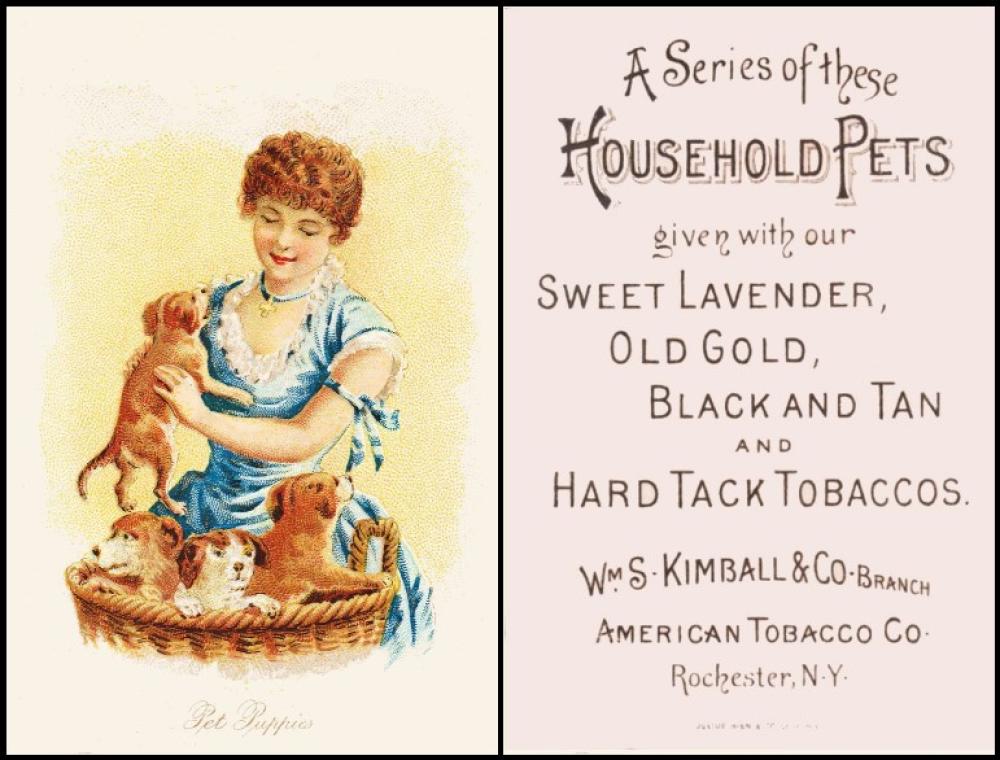
Wm. S. Kimball [tobacco : O/S : USA] “Household Pets” (1891) Un/25 – K401-325 : K26-13 : ABC/194 : USA/194
National Love Your Pet Day
Sadly the text on the front is rather light, but it says “Pet Puppies”. I also like the way that the reverse tells of their brands, though I much prefer the thought of Sweet Lavender than Hard Tack.
This set is catalogued in the original World Tobacco Issues Index as :
HOUSEHOLD PETS. Lg. 95 x 63. A.T.C. back. Unnd (25). See ABC/194. Ref. USA/194
In our updated version the text is slightly different and includes an addition –
HOUSEHOLD PETS. Lg. 95 x 63. A.T.C. back. Unnd (25). A card is known printed around front with advertisement for “C.A. Marrian”. Ref. USA/194
Now C.A. Marrian were listed as selling "Fine Tobaccos, Cigars, Fishing Tackle and Sporting Goods" so I will have a better look in the World Indexes tomorrow. I do already know they were based in Watertown, New York.

Duroyon & Ramette [trade : coffee and chocolate : O/S : France] “Inventions”? Un/
Today in 1878 saw the publication of the World`s first telephone directory, but it was a by product of the world's first public telephone exchange, which was opened by Civil War veteran George Coy. He was the manager of a telegraph office in New Haven, Connecticut, and somehow came to attend Alexander Graham Bell`s inaugural demonstration of the telephone, in April 1877. Maybe he was even sent there by his work.
Anyway he liked the machine and set up the world's first public telephone exchange on January 28, 1878.
Now this part of the story is actually mentioned on our card at the end. In French it says “Il restait a centraliser les courants afin de mettre en rapport plusieurs personnes d`une mem ville c`est a New Haven, dans le Connecticut, que s`ouvrit lew premier poste central, le 1st Janvier 1878”
But three weeks later he had another brainwave, and produced a little list giving all the telephone numbers of the residents of his home town. At that time there were fifty people only, so it was not too onerous a task, and it came out to one sheet. However, despite the size, it was the world's first telephone directory.
Now this card was issued with Chicoree A La Menagere Papier Grains de Café Chocolat Inimitable pur Cacao & Sucre. And Duryon & Ramette were based in Cambrai, Nord. They were founded in 1873 and would end up as part of Leroux, who are still making chicory coffee to this day.

Sniders & Abrahams [tobacco : O/S : Australia] “Dickens Series” (1909) Un/32 – S587-150 : S88-17 : RB.20/20
Today is Be Humble Day, so who else could we celebrate but Uriah Heep, from Charles Dickens` “David Copperfield” – after all he is the King of Humble, who is quoted here as saying “But, you know, we`re so very `umble”
Now this card does not say Sniders & Abrahams, but it does say “O. & Co.” which is universally acknowledged to be a sign of their issues.
This set is first catalogued in the original Australasian Miscellaneous Booklet (RB.20), published in 1951. The listing reads
20. DICKENS SERIES. Size 67 x 38 m/m. Fronts in colour, with captions at base. Brown “Standard” backs (type 15), with descriptive text. Colour of back varies from light yellow brown to deep red brown. Issued 1907-1912 period. Unnumbered Series of 32.
This is followed by a list of the cards, which I will scan and add tomorrow.
It next appears in the original World Tobacco Issues Index as :
DICKENS SERIES. Sm. Unnd. (32). “Standard” brand Issue. See RB.20/20
The updated version is identical apart from the omission of any reference to RB.20
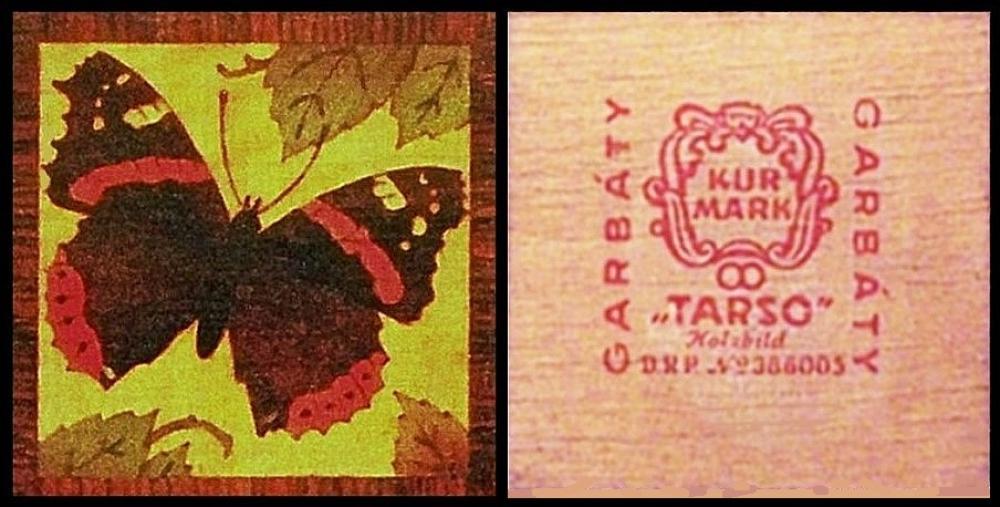
Garbaty [tobacco : O/S : Germany] “Tarso” Holzbild / “Tarso” Holzbild Wood Cards (1932) Un/84 – G090-835 ; G14-31
So here, to close, in honour of #NationalTileDay, this is an actual wooden tile which was issued instead of a cigarette card.
If you look at the tile it says "Kurmark" - but this was the cigarette brand that the tiles were issued with.
The idea was that you used them for crafting, to make boxes etc., just like a kind of marquetry. And there was a large, beautifully illustrated brochure available, which included colour images, illustrating a selection of things that you could decorate or make with the tiles. One of these has been uploaded to the Internet Archive by Stuart Arnold, so you too can see the types of tiles that were available, initials, and images, but also different kinds of woods for someone with perhaps a more refined palate.
The set is catalogued in our World Tobacco Issues Indexes as :
“TARSO” HOLZBILD (“TARSO” Wood Cards). 40 m/m square. Miscellaneous subjects printed in colour on 3-ply wood. Back in red, inscribed “D.R.P. No.386005” (a) with (b) without “84 versch. Motive!” Unnd. (84)
And if anyone has a better one of these very unusual items I will happily accept a scan of it to replace this one is not in great condition and I can do no more to it but make it just about visible.
Actually "Holzbild" means "wooden picture", rather than tile, but I will gloss over that at this late hour.
There were indeed miscellaneous subjects, including numbers and letters, but also the natural world, and buildings. There are also tiles which were to be used for borders, all the same pattern repeating in a long strip one tile after the other.
I find them fascinating!
Garbaty is also intriguing. It was founded by Josef Garbáty-Rosenthal in 1881 in Berlin, and it was also the first company to make the so called "Egyptian" cigarette. They were exported right across the World and the business expanded rapidly, enlarging their premises and buying more land. However in 1938 they were forced to sell out to the German owned Jacob Koerfer Group from Cologne.
The children of Mr. Garbaty Rosenthal then left for America, but he did not, and he died in June 1939.
After the Second World War the factory was badly damaged but they did start to again produce cigarettes. However this did not last and the factory closed in 1995. Today it is once more in use, but as housing.
This week's Cards of the Day...
.. and this week we will be going to the big, and small screen, with Cesar Romero, who was born on February 15, 1907.
Saturday, 10th February 2024
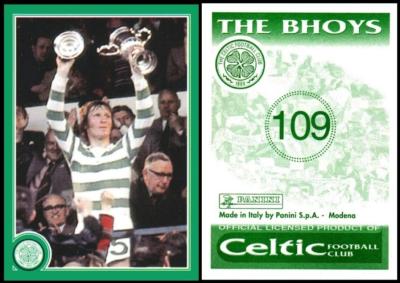
We started the week with Billy Mc Neill, who has a very interesting link to our theme because, according to The Scottish Sun, his nickname of "Cesar" was derived directly from Cesar Romero.
This set of Celtic F.C. cards is split into sections, the first 82 showing the current Celtic Squad, numbers 83-92 being the stadium, the fans, and the team at training, numbers 93-144 being assorted “Magic Moments” in the Club story, and numbers 145-174 being past players.
Be aware there is another set, called “Here Come The Bhoys” this was the follow up which was issued from 2000 to 2001.
Now in case you were wondering, the word “Bhoys” comes from the Gaelic practise of adding an “h” after a “b”.
This is not the Club`s only nickname, for it is also known as The Celts, as a shortening of Celtic, and also because at one time, before transfers in and out of the area were common place, its players were almost exclusively of local and Celtic origin).
Another name is The Tims, which seems to have links back to a gang from the turn of the twentieth century, and is primarily used to refer to the fans rather than the players which makes me think it is more of a sly comment used by rival teams).
Lastly they are called The Hoops, simply because the colours of their strip, since 1903, has been a series of green and white hoops rather than the more usual stripes.
I am not sure I know the difference between a stripe and a hoop, so maybe someone would like to educate me and I can tell everyone else too.
Sunday, 11th February 2024
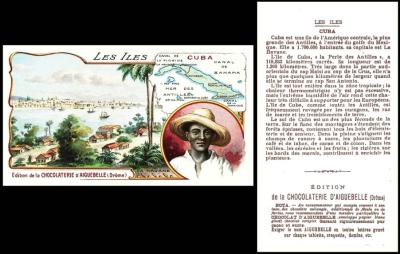
So here we have the Island of Cuba where Cesar Romero`s family originated from – though he was born in New York. His father had been a sugar importer, also called Cesar Romero, whilst his mother, Maria Mantilla, was the natural daughter of the Cuban national José Martí, who was killed in the Battle of the Two Rivers in May 1895 whilst trying to liberate Cuba from its Spanish occupiers.
That leads me to the cards I really wanted here, but could not find, and strangely all of those are from “Geografico Universal” (or The History of Cuba) issued in 1915 with Henry Clay and Bock`s “Cigarros Susini y La Corona, Tabacalera Cubana” brand. One is a portrait of him, one shows his birthplace, and one is an action shot of the moment of his death (bit gloomy that one).
Now the full name of this company is “The Monastery Chocolate Factory of the Trappist Fathers at Aiguebelle”, which is in France. And I was going to research it but someone else has got there first and done an amazing job, even having photographs, so I will bow out gracefully and say nip along to Viva Chocolat - and, by the way, this site covers lots of chocolate makers. It’s well worth a visit, and, indeed, bookmarking, if those sort of cards fall into your area of interest.
I have drawn a blank at finding the year this was issued, or how many there are in this set, but this is the second set of d`Aiguebelle cards that I have listed and both seem to have twenty cards, or rather the list grows steadily until it gets to twenty and then the same ones keep coming back, but no more get added. But if you do know any more do send us the names. However, in a listing of d`Aiguebelle cards in our first ever Cartophilic Notes and News, volume one, number one, for January/February 1965, the listing for this set actually reads :
- L1 - Les Iles. (Islands). 114 x 65. Unnd. (6 known)
The cards in the set are :
- Borneo
- Ceylan [Ceylon]
- Chypre [Cyprus]
- La Crete
- Cuba
- Formose [Formosa]
- Java
- Jersey
- La Sardaigne [Sardinia]
- La Sicile [Sicily]
- Les Baleares [the Balearics]
- Les Canaries
- Les Philippines
- L`Islande [Iceland]
- Madere [Madeira]
- Nouvelle Guinea [New Guinea]
- Nouvelle Zelande [New Zealand]
- Rhodes
- Sumatra
- Terre Neuve [Newfoundland]
Monday, 12th February 2024

The last card was designed to suggest the role that Mr. Romero is most known for, and that was The Joker, in Batman – though he only played him from 1966 to 1968.
Now you may have well been thinking this was the standard Wills Home issue, but it is this curious one, issued overseas. And did you spot that on the top banner of the front, where it usually says "WILLS`S CIGARETTES" this one says "ENGLISH PERIOD COSTUMES"? This is also a much more flamboyant reverse than ours, with its stiff, straight framelines.
The word "Joker" will almost immediately suggest something else to you, which is playing cards. The curious thing is, though, that on most of these, and do go check, the so called "Joker" depicted is dressed as on our card, with the striped attire on his body, and the cap with bells on his head. Yet, as here on our card, we do not call this chap a "Joker" at all, we call him a "Jester". There are regional variances, for example, in Italy this card shows Harlequin of the Comedia Del`Arte.
Popular legend has this card starting during the American Civil War, as part of the game known as Euchre, and it is said by some that Joker is but a mispronounciation of Euchre. Another thought is that it comes from Germany, and a game called Juckerspiel, with the Jucker being anglicised to Joker, though it actually means the Jack. The earliest actual Joker card was made in England by Charles Goodall, though it was not used here for several years, all those first packs being exported to America.
Now this card is a variant of the W.D. & H.O. Wills set of "English Period Costumes" issued in this country in August 1929, However there are differences and variations, which are admirably described in our original Wills reference book part IV as :
195. ENGLISH PERIOD COSTUMES. Fronts printed by letterpress in colour. Backs in grey, with descriptive text (except C).
Small cards, size 67 x 35 m/m. Series of 50
A. Home issue, Wills` name and I.T.C. Clause at base of back. Issued 1929.
B. General Overseas Issue, Anonymous backs, series title front and back.
C. General Overseas issue. Plain backs, unnumbered. Anonymous issue, series title front only.
D. MEDIUM cards, size 70 x 55 m/m. Series of 25. Inscribed "Wills World Renowned Cigarettes". Two grades of board (a) white semi-glossy (b) cream, matt. Issued in Australia 1928
E. LARGE cards, size 79 x 62 m/m. Series of 25. Home issue 1927.
The subjects in A-C are entirely different to those in D-E.
Now though these are not listed in the main body of our British American Tobacco Reference, RB.21, they do appear in the front index, and several gaps to the above are filled. The text there tells us that our set, B., was issued in 1932 in South Africa, whilst set C., with the plain back, was issued in Malaya, I do not know why they were not given any text, or even a design? Does anyone else?
When the Wills part work books were reprinted into a single hard back volume, complete with tables of dates of issue from Wills` own World Magazines, we gained the month of issue for the home set, August 1929. However though there is a table of overseas dates, they are a bit sketchy, and neither of the exported versions appear.
By the time of our World Tobacco Issues Indexes, the sets have been parted. The Home issue now appears with the Wills listing, whilst the export ones appear elsewhere, in sections for anonymous sets with and without letterpress on the backs. Our set is quite early on under ZB, but the Malayan one is a way down further, as ZJ05-26 in the updated volume - and ZJ5-11 in the original.
Tuesday, 13th February 2024
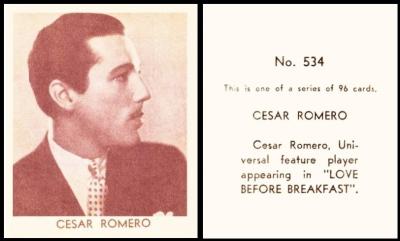
Now oddly this set of 96 cards starts with number 501, of Carole Lombard, which must mean there is at least one set previous to it. However, and quite coincidentally, that first card, 501, also mentions our film "Love Before Breakfast", which was released in March 1936.
This was not Cesar Romero`s first film, that was "The Shadow Laughs" in 1933. In between that and our film there were twelve others, including his second role, which was in "The Thin Man", with William Powell, Myrna Loy, and, of course, Asta.
Though he laughed about it, Cesar Romero was too often the "Latin Lover". He danced his way through several musicals, and even shared the screen with Shirley Temple, starting in 1937 with "Wee Willie Winkie", This was the first of three films in which they appeared together, and in close succession, for this was released in June, and the second, "Ali Baba Goes to Town" in October. The final film, "The LIttle Princess" was released in February 1939.
Shortly before that he had picked up the role of The Cisco Kid, which had just been vacated by Warner Baxter. The film, "The Cisco Kid and The Lady", was released in December 1939, and was the fifth in the series, and it may have had rather a thin plot, but the audience liked the change of faces, and Cesar Romero would go on to make six more of them, until his last in 1941, when production was halted by World War Two. He joined up, and served in the U.S. Coast Guard. The series did return towards the end of the war, but not with Cesar Romero, it was instead split between leading men Duncan Renaldo and Gilbert Roland until 1950.
In 1951, whilst continuing to make movies, including the still popular original "Oceans Eleven", he moved seamlessly to television, starting with what we would today call guest appearances. Several of those were anthologies of small sketches blending familiar names and newcomers, whilst others were brief entries in long running serials, like "77 Sunset Strip", "Dr. Kildare", "Burke`s Law", "The Man From U.N.C.L.E" and "Rawhide".
And then he agreed to take on a part that would change his life for ever. More about that tomorrow!
Now we do not know who issued these cards, but they are a mixture of portraits and film stills. Some people are convinced it is three sets, the first, being cards 501-524, which are all actresses, then the second, cards 525-564 which are all actors, and the third, cards 565-596, being stills, or shots directly from movies. However this is incorrect, as within this last group there are more portraits, of actresses (cards 581-588). Other people then counter by saying this makes five sets, actresses, actors, stills, actresses, and stills again. The problem with both these theories is that the number of each set would vary quite widely.
Anyway, as always, we are open to hearing theories on the issuer, or how the set(s) were made up, and all will be investigated !
We must thank Jefferson Burdick for the code, R.134. He lists this set under "Candy and Gum Cards" but does not supply an issuer, simply listing it as
R.134 - Series of 96 (501-596) Movie Stars and Scenes, colours.
He values them at just three cents each, which means they were either very plentiful, or that he did not like them very much. Sadly we do not know which.
Wednesday, 14th February 2024
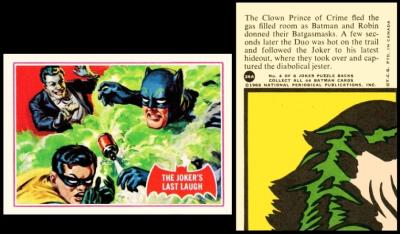
Let us start by saying that T.C.G.C. does indeed stand for Topps Chewing Gum Company. However in this country these sets were also issued by A. & B.C. Gum, who were allowed to produce this, and several other Topps sets, under license.
Now if you look at the back of our card you will see it is sectional. It is actually part of a large picture of the face of The Joker, made up over six cards, numbered 23.A to 28.A inclusive. Going back to the start, the first ten cards, 1.A to 10.A, show Batman., whilst cards 11.A to 16.A is a smaller, six card, portrait of The Riddler, and cards 17.A to 23.A, again just six cards, show Catwoman, though here she is called "The" Catwoman. Then there are our set of six, of the Joker. The next six, numbered 29.A to 34.A make The Penguin, and then it reverts to the starting system, because cards 35.A to 44.A, the final ten cards, make up a picture of Robin.
Now though this Topps American version is not included in our British Trade Indexes, we do have the A & B.C. ones, and the cards are pretty much the same except for the logo.
In our original British Trade Index part II, these are catalogued as :
"BATMAN" Grouping (A). Md. 81 x 55-57. Nd. ... ... ABF-2
2. Front with caption in red, "bat" outline. Sectional back. Nd. 1A to 44A. (44)
In our updated British Trade Index the listing is slightly different, and it is still early enough to type it in, so I will. It reads :
BATMAN (A). 1966. 80-81 x 55-57. Nd. ... ... AAB-040
2. Nd. 1A to 44A. (44). Front caption in red, "bat" outline. (a) matt (b) varnished, Sectional back. Special album.
Thursday, 15th February 2024
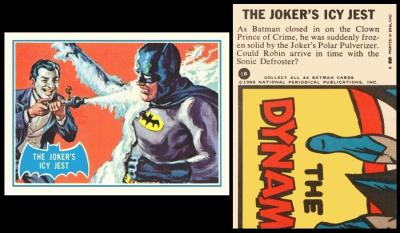
Here we have our man, Cesar Romero, as the Joker, who, although shown in cartoon form, is clearly identifiable. He was actually the first actor ever to portray the character, fresh from its comic book fame, both in the feature film, released in 1966, and in the television series which aired between 1966 and 1968.
These cards were first issued in America, in a wax packet, costing five cents, by a company called Topps, with chewing gum, hence the initials on their cards, "T.C.G." [Topps Chewing Gum]. These cards were then licensed to A. & B.C. Gum in the United Kingdom. Most of the cards are easily proven as to whether they are Topps or A. & B.C. Gum printings because there is a blurry blob on the English ones, which is the trademark of A. & B.C. Gum, not a great trademark though, for it is their initials inside very small cube shaped boxes.
In England the cards retailed with bubble gum, not chewing gum, and each packet retailed for 3d.
As to our set, before we get to the rest, most collectors call this the "blue bat set", because the title on the front is in a bat shaped emblem which is a solid in blue, and to be fair that does distinguish it from the cards with the black bat and the red bat. But it is also known as the "B Series", because on the back of the cards the number in the small black circle is followed by the letter "B".
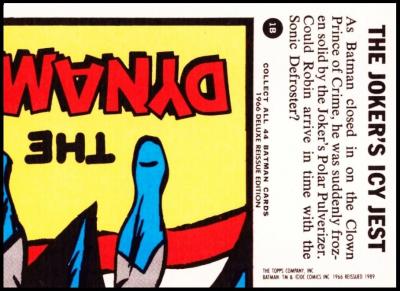
You must "B" careful though, because this sectional blue bat "B Series" was reprinted in 1989, when the live action film of "Batman" was released. These reprints are relatively easy to spot though because there are additional wordings. The most noticeable is right beside the frame of the sectional picture on the reverse where it adds "1966 DELUXE REISSUE EDITION", but it also changes the other wording to read "THE TOPPS COMPANY INC. BATMAN TM & (C) DC COMICS INC. 1966. REISSUED 1989"
Now for even more confusion, because Topps originally produced two different back designs for their cards. The most easily available one has a sectional back making up part of a puzzle, and was the only back version issued by A. & B. C. Gum.
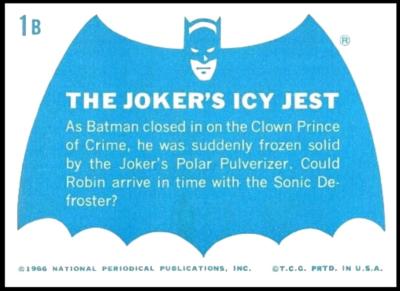
However, once these sectional backed cards had been issued in America in 1966, Topps released a totally different second back, showing here. Though do note that the text on both versions is the same.
Now these are most often known as "cape" cards, because of the back design, but they are also sometimes known as "blue bat back" cards.or as "descriptive" or "story" cards, which is rather confusing as the puzzle cards that we show as our main picture also have descriptive text to one side of the image which tells a story.
To add to the fun, Topps Batman cards were also issued by O-Pee-Chee in Canada, and by Scanlens (Australasia). You really only know which they are when you look closely at the card, and though this is easy enough for O-Pee-Chee because it says "(C) T.G.C PTD CANADA", the Scanlens cards all seem to just say "(C) T.G.C.PRTD U.S.A" which is exactly the same as on the Topps American cards - I have spent a great afternoon looking at the Australian version of eBay, and though the seller`s listings all say Scanlens I have not found a single card that does. So if there is anyone out there who can do a spot of confirming or denying, please do.
Now as this is the first "Batman" card to be a Card of the Day it gets the honour of becoming the home page for the entire grouping. It will also link to the ones we use elsewhere. There will also (one day) be a Topps link in here, which will tackle the fact that most of these were issued in America by Topps. At the moment, because we are only at the start of re-jiggling the index, we have linked to some of those Topps sets below, but this is only a temporary state of affairs.
So the first one of our reference books to show the set is our original British Trade Index part II. The entry below comes from there, but we have amended it to add the links.
"BATMAN" Grouping (A). Md. 81 x 55-57. Nd. ... ... ABF-2
1. Front with caption in black, "bat" outline. Titled "Batman" on back below number (55)
A. Full length picture of Batman on R of text
[see https://csgb.co.uk/publications/newsletter/2023-03-18]
B. Abbreviated picture of Batman on R of text, with inscription "Join the official Batman Fan Club" with details in panel below
[see https://csgb.co.uk/publications/newsletter/2022-09-10]2. Front with caption in red, "bat" outline. Sectional back. Nd. 1A to 44A. (44)
[for the Topps version, see https://csgb.co.uk/cardoftheday/2024-02-14]3. Front with caption in blue, "bat" outline. Sectional back. Nd, 1B to 44B. (44)
[for the Topps version see https://csgb.co.uk/cardoftheday/2024-02-15]4. Front without caption, red number in circle. (55)
A. Sectional back headed "Bat Laffs".
[for the Topps version see https://csgb.co.uk/cardoftheday/2024-02-16]
B. Sectional back headed "Batman" in "bat" outline.5. Front without caption, red imitation corner mounts. Back in black, "The Riddler`s Riddle" in lower half, with answer in code requiring paper "Secret Decoder" slip packed with wrapper (38)
There is an addition to this in our original British Trade Index part III, namely :
ABF-2 ("Batman" Grouping).
5. Front without caption, red imitation corner mounts. Back in black, "The Riddler`s Riddle" (38). An Afrikaans Language issue in South Africa is titled "Het Raadsel Van De Raadselman"
Now in our updated British Trade Index, the cards are catalogued as :
"BATMAN" (A). 1966. 80-81 x 55-57. Nd. ... ... AAB-040
1. Titled "Batman" on back. Nd. (55). Front caption in black. Fronts (a) matt (b) varnished. Two printings. Special album. Backs (a) pink, with "Join the Official Batman Club", abbreviated picture of Batman. (b) pink, without above wording, full picture of Batman
2. Nd. 1A to 44A. (44). Front caption in red, "bat" outline, a) matt b) varnished. Sectional back. Special album
3. Nd, 1B to 44B. (44). Front caption in blue, "bat" outline. Sectional back.
4. Nd. (55). No captions, red number in circle. Sectional backs. Special album. 3 printings.
1. With monogram, front a) matt b) varnished. Backs headed "Bat Laffs".
2. Without monogram, backs headed "Bat Laffs"
3. With monogram, back headed "Batman" in "bat" outline.5. Nd. (38). Black back with "The Riddler`s Riddle" in lower half, with coded answer requiring "Secret Decoder" slip packed with wrapper. Also found in Afrikaans, back "Het Raadsel Van De Raadselman"
Friday, 16th February 2024
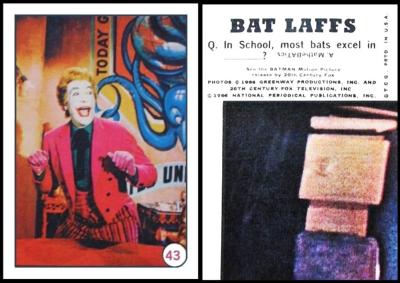
So this again harks back to our Batman listing. This one is
T4. Front without caption, red number in circle. (55)
A. Sectional back headed "Bat Laffs".
B. Sectional back headed "Batman" in "bat" outline.
However in this case as you will see. it is live action, not cartoon, and this, in costume is Cesar Romero.
This set ties in to the feature film, which was released in cinemas, and, like the tv series, starred Adam West as Batman and Burt Ward as Robin. However all the familiar characters were there, apart from Julie Newmar, who played Catwoman. Her suit was filled instead by Lee Meriwether. I have not been able to find out why.
As an added bonus, not all the scenes that appear on these cards appear in the movie, some were promotional shots, and that is what makes this set so interesting to collectors. It is also one of the first to do that, paving the way for all the "Behind the Scenes" cards in more modern film tie-in sets.
Now the cards come either with or without the wording "See the BATMAN Motion Picture release by 20th Century-Fox" above the copyright information. It seems likely that it was there from the start, as extra promotional material, encouraging the card collectors to go and see the film, which was released in July 1966, two months after the series ended. However we do not know why, or when, the line was removed.
Better bring this to a close there, look at the time.
Have a great week, and lets hope you find at least one card to thrill you.
